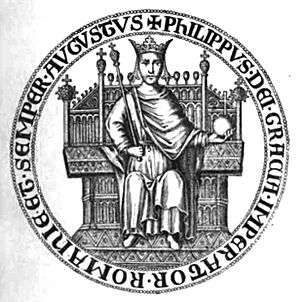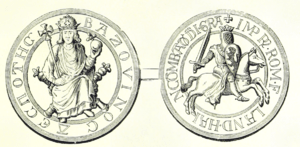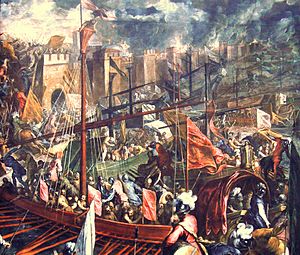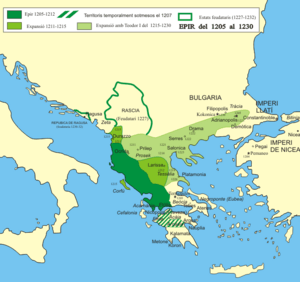Latin Empire facts for kids
Quick facts for kids
Latin Empire
Imperium Constantinopolitanum
Imperium Romaniae Imperium Romanorum |
|||||||||||||||
|---|---|---|---|---|---|---|---|---|---|---|---|---|---|---|---|
| 1204–1261 | |||||||||||||||

The Latin Empire with its vassals (in yellow) in 1204
|
|||||||||||||||
| Capital | Constantinople | ||||||||||||||
| Common languages | Latin, Old French (official) Greek (popular) |
||||||||||||||
| Religion | Latin Catholic (official) Greek Orthodox (popular) |
||||||||||||||
| Government | Feudal Christian Monarchy | ||||||||||||||
| Emperor | |||||||||||||||
|
• 1204–1205
|
Baldwin I | ||||||||||||||
|
• 1206–1216
|
Henry | ||||||||||||||
|
• 1216–1217
|
Peter | ||||||||||||||
| Historical era | High Middle Ages | ||||||||||||||
|
• Sack of Constantinople
|
1204 | ||||||||||||||
|
• Joint Nicean-Bulgarian campaign against Empire
|
1235 | ||||||||||||||
|
• Disestablished
|
1261 | ||||||||||||||
| Area | |||||||||||||||
| 1204 est. | 179,000 km2 (69,000 sq mi) | ||||||||||||||
| 1209 est. | 206,000 km2 (80,000 sq mi) | ||||||||||||||
| 1228 est. | 47,000 km2 (18,000 sq mi) | ||||||||||||||
| 1260 est. | 14,000 km2 (5,400 sq mi) | ||||||||||||||
|
|||||||||||||||
| Today part of | Turkey Greece Bulgaria |
||||||||||||||
The Latin Empire was a special kind of state, called a Crusader state. It was created by the leaders of the Fourth Crusade in 1204. This happened after they captured land from the Byzantine Empire.
The crusaders wanted the Latin Empire to take the place of the Byzantine Empire. They wanted a Catholic emperor instead of an Eastern Orthodox one. The Fourth Crusade was originally meant to recapture Jerusalem from Muslim control. But things changed, and the crusader army ended up attacking Constantinople. This city was the capital of the Byzantine Empire.
The crusaders had planned to put the old Byzantine Emperor, Isaac II Angelos, back on his throne. His son, Alexios IV Angelos, promised them money and military help. This help was supposed to let them continue their journey to Jerusalem. But when the crusaders arrived in Constantinople, things got out of hand. Even though Isaac and Alexios ruled for a short time, the crusaders didn't get the money they were promised. So, in April 1204, they attacked and looted the city. They took its huge wealth.
After that, the crusaders chose their own emperor, Baldwin of Flanders. They divided the Byzantine Empire's land into several new states. These new states were like smaller kingdoms that owed loyalty to the Latin Empire.
The Latin Empire faced challenges right away. Other parts of the Byzantine Empire, led by Greek families, wanted their land back. These groups were in places like Nicaea and Trebizond. The Latin Empire struggled to control these areas. It also had constant wars with Bulgaria and the Greek groups. Eventually, the Nicaean Empire took Constantinople back in 1261. This brought the Byzantine Empire back to life. The last Latin emperor, Baldwin II, had to leave. But the title of emperor was still used by some people for a long time.
The name "Latin Empire" wasn't used when it existed. People at the time called it other things. The Greeks called it Frankokratia, meaning "rule of the Franks." The Latin Emperors themselves used names like "Empire of Constantinople" or "Empire of Romania." The word Romania meant "Land of the Romans." This name had been used by people in the Byzantine Empire for centuries.
Contents
What's in a Name?

The name "Latin Empire" was created by historians much later. It helps them tell the difference between the old Roman Empire, the Byzantine Empire, and this new state. All these empires called themselves "Roman."
Historians use "Latin" because the crusaders were Roman Catholic. They also used Latin as their main language for church and learning. This is different from the local people, who were Eastern Orthodox and spoke Greek. The Byzantines called the Latin Empire Frankokratia or Latinokratia, meaning "rule of the Franks" or "rule of the Latins."
The crusaders' own documents called their empire the imperium Constantinopolitanum. This means "Empire of Constantinople." This name showed they saw themselves as taking over the empire. They didn't see themselves as creating something totally new. It was hard for them to call it "Roman." This is because Western Europe already saw the Holy Roman Empire as the true Roman Empire.

Still, the crusaders knew Constantinople was a Roman capital. They knew the Greek people saw themselves as Romans. The first Latin Emperor, Baldwin I, used a title very similar to the Byzantine emperors. His title was "Emperor of the Romans." On his seals, he used "Rom." This could mean "Romania" (land of the Romans) or "Romanorum" (the Romans). He probably meant "the Romans."
Baldwin's successor, Henry, used different titles. He called himself "Emperor of Romania," "Emperor of the Romans," and "Emperor of Constantinople." Using "Emperor of Constantinople" might have helped him gain support from the local Byzantines. Owning the city of Constantinople itself was a key way to show they were the rightful rulers.
History of the Latin Empire
How the Empire Began

After Constantinople fell in 1204, the crusaders decided to divide the Byzantine lands. They signed a treaty on October 1, 1204. This treaty gave three-eighths of the empire to the Republic of Venice. This included Crete and other islands.
The Latin Empire claimed the rest of the land. They controlled parts of Greece, which were divided into smaller states. These included the Kingdom of Thessalonica, the Principality of Achaea, the Duchy of Athens, and the Duchy of the Archipelago. They also had a short-lived state called the Duchy of Philippopolis.
Some other areas in Asia Minor were planned as duchies. But these plans didn't work out. This was because the Empire of Nicaea quickly formed in that region. The Doge of Venice was not a vassal to the Latin Empire. But Venice controlled a large part of the empire's land. This gave Venice a lot of power in the empire's decisions.
However, much of the old Byzantine land stayed in the hands of Greek rulers. These were states like the Despotate of Epirus, the Empire of Nicaea, and the Empire of Trebizond. All of them wanted to take back their lands from the Latins.
When Baldwin I was crowned in 1204, five different groups claimed to be the true Roman Empire. These were the Latin Empire, the Holy Roman Empire, and the three Greek states. None of these groups actually controlled the city of Rome. Rome was still under the Pope's control.
Latin Empire in Asia Minor

At first, the crusaders had success in Asia Minor. They captured most of Bithynia by 1205. They defeated the forces of Theodore I Laskaris, who was the Emperor of Nicaea. Latin successes continued, and they signed a truce with Theodore in 1207.
The Latins won another battle against Nicaean forces in 1211. Three years later, a treaty recognized their control over most of Bithynia and Mysia. This peace lasted until 1222. By then, Nicaea had grown stronger. The Latin Empire had become weaker from constant wars in Europe.
In 1224, the Latin army was defeated. By the next year, Emperor Robert of Courtenay had to give up almost all his lands in Asia to Nicaea. Only Nicomedia and the areas right across from Constantinople remained. Nicaea also took islands in the Aegean Sea that belonged to the empire. By 1235, all the remaining Latin lands in Asia had fallen to Nicaea.
Latin Empire in Europe
In Europe, the Latin Empire faced a strong enemy: the Bulgarian tsar Kaloyan. When Baldwin fought against Greek lords in Thrace, they asked Kaloyan for help. In April 1205, at the Battle of Adrianople, the Latin knights were defeated. Emperor Baldwin was captured and died later that year.
Kaloyan was murdered in 1207 during a siege. The Bulgarian threat was finally ended in 1208. This allowed Baldwin's successor, Henry of Flanders, to take back most of the lost lands in Thrace. Peace was made in 1210 when Henry married Maria of Bulgaria, Kaloyan's daughter.

At the same time, another Greek state, the Despotate of Epirus, was a threat. Its leader, Michael I Komnenos Doukas, attacked the empire's smaller states. Henry forced Michael to submit in 1209. This alliance allowed Henry to campaign in Macedonia and Thessaly.
In 1214, Michael died. His successor, Theodore Komnenos Doukas, wanted to capture Thessalonica. In 1216, Henry died. He was replaced by Peter II of Courtenay, who was captured and killed by Theodore the next year. A group of regents ruled Constantinople. They waited for help from the Pope and the King of France. But the Latin Empire couldn't stop Thessalonica from falling to Epirus in 1224.
Epirote armies then conquered Thrace and reached Constantinople. The Latin Empire was saved for a short time. This was because the Bulgarian tsar Ivan II Asen threatened Theodore. A truce was made in 1228.
Decline and Fall
After Robert of Courtenay died in 1228, John of Brienne became the new regent. The Epirote threat ended after a big defeat by the Bulgarians. But then Nicaea became the new danger. It started taking over lands in Greece.
In 1235, Emperor John III Doukas Vatatzes of Nicaea made an alliance with Bulgaria. They launched a joint attack on the Latin Empire. They tried to capture Constantinople but failed. In 1237, Baldwin II became old enough to rule. But the empire was much smaller and weaker.
Baldwin often traveled to Western Europe to ask for help. He usually didn't succeed. To get money, he had to do desperate things. He sold the lead roofs of the Great Palace. He even gave his only son, Philip, to Venetian merchants as a guarantee for a loan.
By 1247, the Nicaeans had almost surrounded Constantinople. Only the city's strong walls kept them out. A major battle in 1259 showed that Latin power in Greece was ending. On July 25, 1261, most Latin troops were away fighting. The Nicaean general Alexios Strategopoulos found an unguarded entrance to the city. He entered with 800 troops and brought back the Byzantine Empire. His leader was Michael VIII Palaiologos.
The remaining Latin states continued to rule parts of modern-day Greece. Some of them lasted until the 18th century. These are known as Latinokratia states. For about a hundred years, Baldwin II's heirs still used the title "Emperor of Constantinople." They were seen as the rulers of the remaining Latin states in the Aegean Sea.
How the Empire Was Run
Administration
The Latin Empire was set up using Western European feudal rules. This means it had a system of lords and vassals. It also used some ideas from the Byzantine government. The emperor had a council to help him. This council included important lords and the Venetian leader in Constantinople.
This council had a big say in how the empire was run. Especially when a regent was ruling, they needed the council's approval. The Venetian leader was very powerful. He was almost independent of the emperor. He controlled the Venetian parts of Constantinople and other Venetian lands. He was like an ambassador for Venice. He even had the right to wear special imperial boots, just like the emperor.
Economy
The Latins didn't trust the Greek officials who handled money. So, they completely changed the Greek economic system. This caused big problems. It disrupted all kinds of production and trade. From the very beginning, the Latin Empire asked the Pope for help.
For a few years, they exported wheat and furs from the area. Constantinople's location on major trade routes also helped. The empire was somewhat strong when Henry of Flanders was alive. But after he died in 1216, there was a big lack of leadership. By the 1230s, Constantinople faced a major shortage of basic food.
One of the main ways the Latin Empire made money was by selling relics. These were holy objects looted from Greek churches. They sold them to Western Europe. For example, Emperor Baldwin II sold the Crown of Thorns while he was in France trying to raise money.
Society
The most powerful people in the empire were the Frankish and Venetian lords. This group included the emperor, the barons, and other lower-ranking lords. Some former Byzantine nobles were also part of this group. Most of the people were Orthodox Greeks. They were still divided into social classes based on how much land they owned.
Church
The Latin Empire changed the church leadership. The Orthodox leaders were replaced by Roman Catholic ones. But the Orthodox church itself was not completely stopped. A large Catholic church system was set up. It was overseen by the Latin archbishop of Constantinople and a special representative of the Pope.
Western Catholic religious groups, like the Cistercians, Dominicans, and Franciscans, also came to the empire. The Orthodox clergy kept their traditions and customs. This included their right to marry. But they were put in a lower position, under the local Latin bishops.
See also
 In Spanish: Imperio latino para niños
In Spanish: Imperio latino para niños


